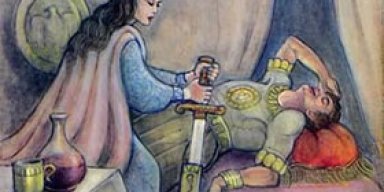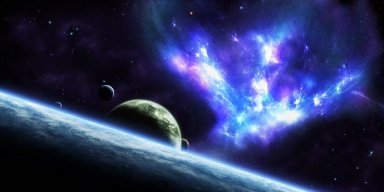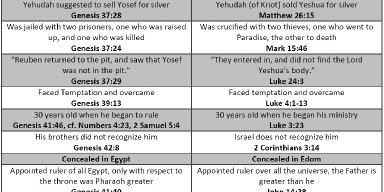This shiur, in honor of “P’tichat haTorah”, is dedicated to my lovely wife, Stefanie, who has been a constant source of support, inspiration and patience; many’s the late Tuesday or Wednesday night when she has agreed to listen to a last-minute idea, to proof-read a shiur or to let household duties wait until the shiur was finished. Sheli v’Shelakhem Shelah Hu – everything I have merited writing and everything you have enjoyed reading – is to her credit.
I
BY WAY OF INTRODUCTION…
In the first story of Man’s creation (see below), God declares: “Let us (?) make Man in our (?) Image” (B’resheet 1:26). Besides the theological problems raised by the use of the plural (for instance, the Septuagint, the Greek translation of the Tanakh generated in the Alexandrian community in the first century BCE, renders this in the singular due to the significant problems raised by “our Image”; see also Rashi ibid; note also the fascinating comment of Ramban here), there is a more “anthropological” issue here – what does it mean to be created in the Image of God? Indeed, not only in Chapter 1, but again at the beginning of the “begats” (Chapter 5), the Torah declares that God created Man in His Image. How do we understand this description?
Rashi explains that “image” here refers to the ability to reason. Rav Soloveitchik z”l expands on this theme, building on the context of creation, and defines Man’s “Divine Image” as the creative spark; that uniquely human ability to enter an environment, whether intellectual or social, and to devise an innovative way to overcome obstacles which prevent that environment from flourishing. In the intellectual arena, this means the innovative mode of thought known, in circles of Torah study, as “Hiddush”. A Hiddush is an explanation which resolves contradictions in the text, which clarifies the conceptual background of various sides of a dispute – in short, a Hiddush is “digging well below the surface” of study in order to unearth the principle which drives the idea of that particular text. The difficulty inherent in any Hiddush is that there is, ultimately, no way to be certain if the Hiddush is “valid”; the ring of truth may be a hollow one, resonating only in the ears of the innovator.
It is our hope that the Hiddushim shared in this shiur, week after week, will resonate with our readership and that they will clarify more than they confound.
II
B’RESHEET – THE “GENESIS” OF A PROBLEM
Following the Torah’s recounting – how long did Creation take? When (in that sequence) was Man created? When were the animals created? Where does the creation of Woman fit within this matrix?
Although most people would give singular answers to each of these questions (Creation took six or seven days, depending if you reckon Shabbat; Man was created on the sixth day; the animals were created just before that; Woman was created from Man’s rib [sic]), the reality of the Torah’s narrative is far more complex.
Not only are there two different stories of Creation (the first story continues from 1:1 until the middle of 2:4; the second continues from there); but, from a purely text-driven read of the information, the accounts are contradictory! In the first story, creation takes six or seven days, Man is created as a complete (single male-female) being at the apex of Creation. In the second story, Creation takes one day, Man is created as a lonely being at the beginning of the process. Woman is formed from Man – and is his “completion” – at the end of this “Creation process”. Among the most pronounced differences between the two stories is the Name for God; in the first story, God is exclusively referred to as the generic “Elohim”; whereas in the second story, He is consistently called “Hashem (YHVH) Elohim”.
These differences are among the stronger “arguments” marshalled by the school of “Bible Criticism”, which, for the past 300 years, has been at the forefront of secular (and non-Orthodox) study of Tanakh. This school of thought (which is really many different schools, each with its own variation) maintains that the Torah is not the unified Word of Hashem; rather they see it as a patchwork of narratives, legal texts and prophecy/poetry, each produced by a different community of priests and scholars during the 10th-6th centuries BCE, which were woven into the Torah as we know it – sometime around the era of Ezra’s leadership (5th c. BCE).
The Bible critics maintain that each of these communities had a different “version” of Creation, a different Name for God etc. – thus explaining the many apparent discrepancies and stylistic variations within the text.
For a myriad of reasons both in the areas of creed and scholarship, we absolutely reject this “Documentary Hypothesis”. Our belief is that the entire Torah was given by God to Mosheh (ignoring for a moment the problem of the last 8 verses) and that the authorship is not only singular, it is exclusively Divine. These two statements of belief – whether or not they can be reasonably demonstrated (and there is much literature, both medieval and contemporary, coming down on both sides of this question) – are two of the 13 principles enumerated by the Rambam.
Because both intellectual honesty and religious tenet prevent us from positing that the Divine Author presents inconsistent information, how can we explain the “multiple versions” – and apparent contradictions within the text?
III
TWO BASIC APPROACHES
From the perspective of tradition there are several ways to resolve these apparent contradictions. Most of them can be categorized into one of two basic approaches.
APPROACH #1: EACH VERSION COMPLETES THE OTHER
Fundamentally (no pun intended), we could try to “meld” the stories together. Rashi adopts this approach; for instance, in his commentary on the first verse in the Torah, Rashi notes that the first version of Creation uses the name “Elohim” for God – denoting strict justice (a court of law is also called Elohim – see Sh’mot 21:6), whereas the second version includes both the name “YHVH” and “Elohim” – indicating that although God’s original intention was to create a world that would operate according to strict justice, He saw that that world could not last, so He integrated compassion (indicated by “YHVH” – see Sh’mot 34:6) into the process.
[We will temporarily suspend discussion of the theological difficulties raised by claiming that God "changed His mind”].
The Gemara in Ketubot (8a) takes a similar approach to the two versions of the creation of Woman – “originally God intended to create them as one being, but in the end He created them as separate individuals”.
There are many examples of this approach, which is a distinct thread of exegesis in Rabbinic and medieval commentary. The upshot of this approach is that each version tells “part of the story” – and the “alternate version” completes the picture.
This approach has been adopted by some contemporary authors who attempt to “reconcile” science and Torah (why this attempt may not be necessary and may, indeed, be misleading and harmful, will be addressed in the shiur on Parashat Noach). The thinking goes as follows: Since each version provides only “part” of the information, it stands to reason that we may “synthesize” the versions together in various ways – including those which appear compatible with modern scientific theories about the origin of the universe, age of the earth and origin of the species.
In any case, this approach is both well-known and ubiquitously applied throughout Rabbinic exegesis regarding the Creation story (stories).
For purposes of our discussion, we will introduce another approach, which has its roots in Rabbinic literature and which was adopted by several Rishonim and more recent commentators, including Rabbi Yosef Dov haLevi Soloveitchik zt”l.
APPROACH #2: CHANGING THE FRAME OF REFERENCE
Both the problem – and the various solutions proposed by the proponents of the first approach – are predicated on an understanding of the role of the Torah which is not the only valid one.
IV
TWO TYPES OF TRUTH
A brief segue on the nature of “Truth” is in order here:
There are statements which fall under the category of “Mathematical Truth”; for instance, that 7 times 9 equals 63 is not only an uncontested statement; it is also the only acceptable one. In other words, 7 times 9 MUST equal 63; if it equals anything else, something is wrong with the computation. Mathematical Truth is not only consistent, it is also exclusive.
If we maintain that the Torah is speaking the language of “Mathematical Truth”, we have no recourse but to satisfy the two sides of the contradiction and either demonstrate that there is no contradiction at all – or to “weave” the information together (as demonstrated above).
There is, however, another type of statement which does not admit to “Mathematical Truth”; we will refer to it as “Ontological Truth” – (the reality about living, growing and dynamic beings). For instance, whereas it would be accurate to say that a certain boy loves to play baseball – that does not tell the full story of the boy. He is also afraid of spiders, excited about his upcoming trip to Washington and has great aptitude in science. Whereas 7 times 9 cannot equal anything but 63, the boy can simultaneously be a baseball fan, a science whiz and arachnaphobic.
As many commentators have pointed out (e.g. see S’forno’s introduction to B’resheet, Shadal’s introduction to his commentary on the Torah; note also Rashi’s second comment on B’resheet), the goal of the Torah is not to present “Mathematical Truths” in the realms of biology, mathematics or “the origin of Man”; rather the Torah is geared to teaching us basic principles of faith, shaping proper attitudes towards the world around us, towards God and fellow humans. In addition – and most critically, the Torah’s aim is to build a holy nation that will ultimately teach the basic truths and ethics of the Torah (note D’varim 4:6) to the entire world.
That being the case, we may certainly understand the various versions of creation as relating to different aspects of the world and of Man – and, notably, of Man’s relationship with both the world around him and with the Creator.
We can then look at each story not as a “mathematical statement” which is either true or false – and is vulnerable to contradiction from another, equally valid source (such as the next chapter!); rather, we look at each version as a series of “ontological statements”, geared to teaching us signficant and focal perspectives about who we are and how we should act.
V
TWO STORIES:
HEAVEN AND THE EARTH;
THE EARTH AND HEAVEN
We may find a clue into the “dual” nature of the Creation narrative via a careful look at the point where the two stories “meet” – immediately after the Shabbat narrative (2:1-3):
These are the products of the heaven and earth when they were created,
On the day when YHVH God made the earth and the heaven
Note that the first half of this verse is a perfect conclusion to the “first version”; it utilizes the common “Eleh” (these…) concluding formula. Note also that just as the first story began with the creation of “Shamayim va’Aretz” – (Heaven and earth); this half-verse seems to conclude that creation.
The second half begins a new “story” – or another perspective of the same story. “On the day when YHVH God made the EARTH and HEAVEN”. Note that the order is reversed – this is a deliberate move on the part of the text to shift the emphasis and the perspective of the story.
Now let’s see what the two stories are – which two perspectives of Creation are being presented here.
[M[Much of this material based on the "Adam I & Adam II” theory of Rav Soloveitchik zt”l – the interested reader is directed to his opus: The Lonely Man of Faith]
VI
VERSION #1:
THE STORY OF THE WORLD
The first version is, indeed, the story of the creation of the heaven and the earth – in other words, it is the story of the creation of the world from a Divine perspective. It begins with the Heavens, presenting an orderly world structured in an hierarchical manner in which every manner of life has its place (note the refrain of “according to its species” in the third, fifth and sixth days). Man is created as the final, crowning touch of this glorious labor – and is formed “in God’s image” in order to be His “agent”, as it were, on earth: “…fill the earth and subdue it, having dominion over the fish of the sea…” (1:28). Man is complete, Man is a master over his world and Man needs for nothing. Man here is also not commanded – God blesses him with fertility, but there is no direct relationship between Man and God in this version.
This is truly the story of the world; an orderly world created by God in which Man can be His partner, His agent – but not His “servant”. The Name for God which denotes compassion – YHVH – is totally missing from this account, since there is no need for Divine compassion where there is no Divine command and no Divine worship.
VII
VERSION #2:
THE STORY OF MAN
There is another side to the story – the story of “the earth and the heavens” – the story from the perspective of Man (God is still “telling” the story – but from Man’s point of view).
From the human perspective, everything created serves a human purpose; even the animals can serve as Man’s companions (and thus are “created” after him) – but Man is not nearly as complete as the “detached” view would have it. Man is lonely, Man seeks out God as he seeks out meaning in this world of alienation and discord. This is a world where nothing grows because “there is no man to work the land” (2:5). God forms Man and then, around him and for his sake, creates a beautiful world of orchards and rivers. Immediately, the most crucial point in their relationship is realized – God commands Man! Man is no longer lonely, on one level, because he is in relationship with God. From a different perspetive, however, he is lonely – because there is no one with whom to share this new life. Unlike the first – “detached” – story, in which everything is assessed as “good” (and, ultimately, “very good”), the first “non-good” thing is introduced – loneliness (2:18). As we follow “Adam II” through his bouts with temptation, guilt, cowardice, etc., we learn more about who he is – and who we are.
The Torah is not telling us two conflicting versions about creation; rather, we are seeing two sides of the same coin. The world is, indeed, an orderly place of hierarchical systems, where Man is the ultimate creature; yet, the world is also a place where Man feels alien and distant, seeking out companionship and meaning in his relationships with fellow humans, with a mate, and with God.








